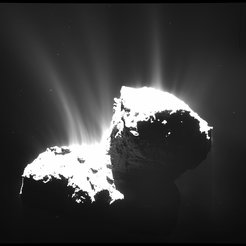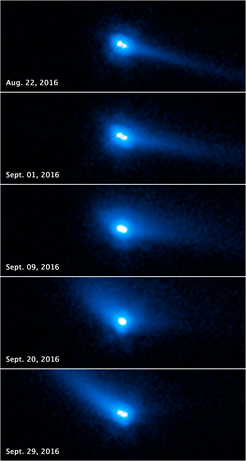Small and active
New research group at MPS: Jessica Agarwal investigates the activity of comets and asteroids in the framework of a Starting Grant of the European Research Council.
With a diameter of at most a few hundred kilometers, asteroids and comets are among the smallest inhabitants of our solar system. Nonetheless, the irregularly shaped bodies are far from negligible: they populate the areas between the orbits of Mars and Jupiter and beyond Neptune by the millions. Scientists also consider them to be relicts from the early days of the solar system. What do the "small bodies" tell about our solar system and its origin? And how have they changed since their creation? These are the questions that Dr. Jessica Agarwal from the Max Planck Institute for Solar System Research (MPS) addresses in the new research group "Activity of comets and asteroids". Over the next five years, the European Research Council (ERC) will support the project with a Starting Grant.
"The past 4.5 billion years since the birth of the solar system have left their traces on both comets and asteroids”, says Agarwal. To understand what information about the early solar system they actually still contain, she therefore wants to study how they have changed since then. The activity of these so-called small bodies plays a crucial role in this endeavor.

Comets, for example, spend most of their lives as frozen chunks on the icy edge of the solar system beyond Neptune. However, if they advance into the inner solar system a transformation takes place: under the influence of the Sun frozen gases such as water and carbon monoxide evaporate and carry dust particles into space. The comet becomes active: it develops an atmosphere and a tail; parts of its surface erode.
"Only since the Rosetta mission is it possible to study in detail, how this activity changes a comet”, says Agarwal. ESA’s Rosetta mission arrived at comet Churyumov-Gerasimenko in August 2014 and accompanied it for more than two years on its path through the inner solar system. By comparison, all previous comet missions have provided only brief snapshots of their research objects.

In addition to the extensive data of the Rosetta mission, Agarwal intends to use observations with space- and ground-based telescopes. In this area, too, research has developed rapidly in recent years. Thanks to better observational possibilities, unusual asteroids exhibiting comet-like activity have been discovered in the asteroid belt, the region between the orbits of Mars and Jupiter. Approximately 20 such bodies are currently known.
In most cases, a breakup – either after a collision or as a result of rapid rotation – triggers the observed activity: subsurface ice is exposed and can then evaporate into space. "It's still unclear why some asteroids contain subsurface ice, but others do not," explains Agarwal. However, the active asteroids could provide an important piece of the puzzle to understand where in the solar system water survived and how the asteroid belt developed. "Our prospects of answering these questions have never been as good as they are today," says Agarwal.
Jessica Agarwal studied physics at the University of Jena and at the Free University of Berlin. Already in her doctoral thesis at the University of Heidelberg (seven years before the arrival of the Rosetta probe at comet 67P/Churyumov-Gerasimenko) she turned to Rosetta’s comet. This was followed by research periods at the European Space Research and Technology Center in Noordwijk (Netherlands) and at the University of Potsdam. Since 2012 Jessica Agarwal has been working at MPS.

With its Starting Grants, the European Research Council annually supports young scientists from all fields of research who are at the beginning of their careers. The Starting Grants are internationally highly regarded and very competitive: Of a few thousand applications, on average, only about eleven percent per year are granted. The selected researchers have the opportunity to set up their own research group and independently pursue a novel and innovative research project.














